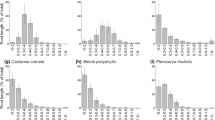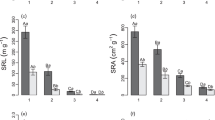Abstract
Background and aims
Plants can develop various root traits which may contribute to their nutrient acquisition. We investigated the occurrence of five root traits among species of genus Carex to determine their frequency, mutual associations and dependence on taxonomy (subgenus) or habitat.
Methods
Root samples of 40 species were collected in their natural habitats within Russia and Belarus. They were examined microscopically to quantify the abundance of AM-fungal hyphae (H), arbuscules (A) and vesicles (V), dark septate endophyte (DSE), typical (long) root hairs (TRH), bulbous (shortened) root hairs (BRH) and dauciform roots (DR).
Results
The frequency of root traits decreased in the order TRH (100% of the species), DSE (80%), BRH (43%), A and V (25%) and DR (23%). Most species possessed 2–4 different traits, but up to five were possible, even on a single plant. Traits occurred largely independently of each other. DR were only found in subgenus Carex and mainly in grasslands. DSE and BRH were more abundant in subgenus Carex. BRH were most abundant in wetlands, TRH were shortest and thinnest in grasslands.
Conclusions
A diversity of root traits exists in the genus Carex, with variation both among and within species. The abundance and size of traits exhibits some taxonomic and ecological patterns, which differ for each trait.



Similar content being viewed by others
Explore related subjects
Discover the latest articles and news from researchers in related subjects, suggested using machine learning.References
Afonin AN, Greene SL, Dzyubenko NI, Frolov AN (eds.) (2008) Interactive Agricultural Ecological Atlas of Russia and Neighboring Countries. Economic Plants and their Diseases, Pests and Weeds [Online]. Available at: http://www.agroatlas.ru
Barrow JR, Osuna P (2002) Phosphorus solubilization and uptake by dark septate fungi in fourwing saltbush, Atriplex canescens (Pursh) Nutt. J Arid Environ 51:449–459
Bates TR, Lynch JP (2001) Root hairs confer a competitive advantage under low phosphorus availability. Plant Soil 236:243–250
Berntson GM (1997) Topological scaling and plant root system architecture: developmental and functional hierarchies. New Phytol 135:621–634
Brundrett МC (2009) Mycorrhizal associations and other means of nutrition of vascular plants: understanding the global diversity of host plants by resolving conflicting information and developing reliable means of diagnosis. Plant Soil 320:33–37
Davies J, Briarty LG, Rieley JO (1973) Observations on the swollen lateral roots of the Cyperaceae. New Phytol 72:167–174
Delaux P-M, Varala K, Edger PP, Coruzzi GM, Pires JC, Ané J-M (2014) Comparative phylogenomics uncovers the impact of symbiotic associations on host genome evolution. PLoS Genet 10:e1004487
Della Monica IF, Saparrat MCN, Godeas AM, Scervino JM (2015) The co-existence between DSE and AMF symbionts affects plant P pools through P mineralization and solubilization processes. Fungal Ecol 17:10–17
Edwards KA, Jefferies RL (2010) Nitrogen uptake by Carex aquatilis during the winter–spring transition in a low Arctic wet meadow. J Ecol 98:737–744
Egorova TV (1999) The sedges (Carex L.) of Russia and adjacent states (within the limits of the former URSS). Takhtajan AL (ed). St. Petersburg Chemical-Pharmaceutical Academy, St-Petersburg; Missouri Botanical Garden Press, Saint-Louis
Gao Q, Yang ZL (2016) Diversity and distribution patterns of root-associated fungi on herbaceous plants in alpine meadows of southwestern China. Mycologia 108:281–291
Ghosh A, Bhujel S, Maiti GG (2014) Occurrence of mycorrhizae in some species of Carex (Cyperaceae) of the Darjeeling Himalayas, India. International Journal of Life Science and Pharma Research 4:1–10
Global Carex Group (2015) Making Carex monophyletic (Cyperaceae, tribe Cariceae): a new broader circumscription. Bot J Linn Soc 179:1–42
Güsewell S (2005a) High nitrogen: phosphorus ratios reduce nutrient retention and second year growth of wetland sedges. New Phytol 166:537–550
Güsewell S (2005b) Nitrogen and phosphorus resorption efficiency of wetland graminoids with contrasting N:P ratios. Funct Ecol 19:344–354
Güsewell S (2017) Regulation of dauciform root formation and root phosphatase activities of sedges (Carex) by nitrogen and phosphorus. Plant Soil, in press.
Güsewell S, Koerselman W (2002) Variation in nitrogen and phosphorus concentrations of wetland plants. Persp Plant Ecol Evol Syst 5:37–61
Güsewell S, Schroth MH (2017) How functional is a trait? Phosphorus mobilisation through root exudates differs little between Carex species with and without specialised dauciform roots. New Phytol, accepted pending revisions
Harrington TJ, Mitchell DT (2002) Colonization of root systems of Carex flacca and C. pilulifera by Cortinarius (Dermocybe) cinnamomeus. Mycol res 106:452–459
Haselwandter K, Read DJ (1982) The significance of a root-fungus association in two Carex species of high-alpine plant communities. Oecologia 53:352–354
Lagrange A, L’Huillier L, Amir H (2013) Mycorrhizal status of Cyperaceae from new Caledonian ultramafic soils: effects of phosphorus availability on arbuscular mycorrhizal colonization of Costularia comosa under field conditions. Mycorrhiza 23:655–661
Laliberté E, Lambers H, Burgess TI, Wright SJ (2015) Phosphorus limitation, soil-borne pathogens and the coexistence of plant species in hyperdiverse forests and shrublands. New Phytol 206:507–521
Lambers H, Shane MW (2007) Role of root clusters in phosphorus acquisition and increasing biological diversity in agriculture. In: scale and complexity in plant systems research: Gene-Plant-crop relations. Spiertz JHJ, Struik PC and van Laar HH (eds). Springer, pp 237–250.
Lambers H, Raven JA, Shaver GR, Smith SE (2008) Plant nutrient-acquisition strategies change with soil age. Trends Ecol Evol 23:95–103
Lambers H, Brundrett MC, Raven JA, Hopper SD (2011) Plant mineral nutrition in ancient landscapes: high plant species diversity on infertile soils is linked to functional diversity for nutritional strategies. Plant Soil 334:11–31
Lambers H, Clements JC, Nelson MN (2013) How a phosphorus-acquisition strategy based on carboxylate exudation powers the success and agronomic potential of lupines (Lupinus, Fabaceae). Am J bot 100:263–288
Lamont BB (1993) Why are hairy root clusters so abundant in the most nutrient-impoverished soils of Australia? Plant Soil 155(156):269–272
Lipson DA, Schadt CW, Schmidt SK, Monson RK (1999) Ectomycorrhizal transfer of amino acid-nitrogen to the alpine sedge Kobresia myosuroides. New Phytol 142:163–167
Massicotte HB, Melville LH, Peterson RL, Luoma DL (1998) Anatomical aspects of field ectomycorrhizas on Polygonum viviparum (Polygonaceae) and Kobresia bellardii (Cyperaceae). Mycorrhiza 7:287–292
Meney KA, Dixon KW, Scheltema M, Pate JS (1993) Occurrence of vesicular mycorrhizal fungi in dryland species of Restionaceae and Cyperaceae from south-west Western Australia. Aust J bot 41:733–737
Miller RM (2005) The nonmycorrhizal root – a strategy for survival in nutrient-impoverished soils. New Phytol 165:655–658
Miller RM, Smith CI, Jastrow JD, Bever JD (1999) Mycorrhizal status of the genus Carex (Cyperaceae). Am J bot 86:547–553
Muthukumar T, Udaiyan K (2000) Arbuscular mycorrhizas of plants growing in the Western Ghats region, southern India. Mycorrhiza 9:297–313
Muthukumar T, Udaiyan K, Vasantha K, Kleiner D, Manian S (1999) Mycorrhizae in sedges as related to root character and its ecological significance. Pertanika J Trop Agric Sci 22:9–17
Muthukumar T, Udaiyan K, Shanmughavel P (2004) Mycorrhiza in sedges – an overview. Mycorrhiza 14:65–77
Nobis A, Błaszkowski J, Zubek S (2015) Arbuscular mycorrhizal fungi associations of vascular plants confined to river valleys: towards understanding the river corridor plant distribution. J Plant res 128:127–137
Playsted CWS, Johnston ME, Ramage CM, Edwards DG, Cawthray GR, Lambers H (2006) Functional significance of dauciform roots: exudation of carboxylates and acid phosphatase under phosphorus deficiency in Caustis blakei (Cyperaceae). New Phytol 170:491–500
Qin S, Wang H-B, Chen H-H, Zhang Y-Q, Jiang C-L, Xu L-H, Li W-J (2008) Glycomyces endophyticus sp. nov., an endophytic actinomycete isolated from the root of Carex baccans Nees. Int J Syst Evol Micr 58:2525–2528
Read DJ, Koucheki HK, Hodgson J (1976) Vesicular-arbuscular mycorrhiza in natural vegetation system. New Phytol 77:641–653
Ruotsalainen AL, Väre H, Vestberg M (2002) Seasonality of root fungal colonization in low alpine herbs. Mycorrhiza 12:29–36
Shane MW, Lambers H (2005) Cluster roots: a curiosity in context. Plant Soil 274:101–125
Shane MW, Dixon KW, Lambers H (2005) The occurrence of dauciform roots amongst Western Australian reeds, rushes and sedges, and the impact of phosphorus supply on dauciform-root development in Schoenus unispiculatus (Cyperaceae). New Phytol 165:887–898
Shane MW, Cawthray GR, Cramer MD, Kuo J, Lambers H (2006) Specialized ‘dauciform’ roots of Cyperaceae are structurally distinct, but functionally analogous with ‘cluster’ roots. Plant Cell Environ 29:1989–1999
Sieber TN, Grünig CR (2013) Fungal root endophytes. In: plant roots – the hidden half, 4th ed. Eshel A, Beeckman T (eds). CRC Press, Taylor and Francis Group, Boca Raton, pp 38-1–38-49
Song GC, Yasir M, Bibi F, Chung EJ, Jeon CO, Chung YR (2011) Nocardioides caricicola sp. nov., an endophytic bacterium isolated from a halophyte, Carex scabrifolia Steud. Int J Syst Evol Micr 61:105–109
Spalink D, Drew MT, Pace MC, Zaborsky JG, Starr JR, Cameron KM, Givnish TJ, Systma KJ (2016) Biogeography of the cosmopolitan sedges (Cyperaceae) and the area-richness correlation in plants. J Biogeogr 43:1893–1904
Uma E, Muthukumar T, Sathiyadash K, Muniappan V (2010) Mycorrhizal and dark septate fungal associations in gingers and spiral gingers. Botany 88:500–511
Vance CP, Uhde-Stone C, Allan D (2003) Phosphorus acquisition and use: critical adaptations by plants for securing a nonrenewable resource. New Phytol 157:423–447
Veselkin DV, Konoplenko MA, Betekhtina AA (2014a) The ability to form mycorrhiza in the genus Carex L. (Cyperaceae): the published data analysis. Plant Life of Asian Russia 16:26–35
Veselkin DV, Konoplenko MA, Betekhtina AA (2014b) Means for soil nutrient uptake in sedges with different ecological strategies. Russ J Ecol 45:547–554
Visser EJW, Bögemann GM, van de Steeg HM, Pierik R, Blom CWPM (2000) Flooding tolerance of Carex species in relation to field distribution and aerenchyma formation. New Phytol 148:93–103
Wang B, Qiu Y-L (2006) Phylogenetic distribution and evolution of mycorrhizas in land plants. Mycorrhiza 16:299–363
Weishampel PA, Bedford BL (2006) Wetland dicots and monocots differ in colonization by arbuscular mycorrhizal fungi and dark septate endophytes. Mycorrhiza 16:495–502
Zemunik G, Turner BL, Lambers H, Laliberté E (2015) Diversity of plant nutrient-acquisition strategies increases during long-term ecosystem development. Nat Plants 1:1–4
Acknowledgements
The authors are grateful to A.A. Betekhtina for advice; to N.V. Zolotareva for providing some samples; and to N.B. Kuyantseva for organizing the fieldwork. They also thank Hans Lambers and two referees for constructive comments on a first version of the manuscript. The work was supported by Act 211 Government of the Russian Federation, contract № 02.A03.21.0006; by the Ural Federal University (a grant for the young scientists, а graduate students and students, contract no. 1.2.2.2-14/99 on March 31, 2014) and by the Russian Foundation for Basic Research (project no. 16–54–00105).
Author information
Authors and Affiliations
Corresponding author
Electronic supplementary material
ESM 1
(DOC 312 kb)
Rights and permissions
About this article
Cite this article
Konoplenko, M.A., Güsewell, S. & Veselkin, D.V. Taxonomic and ecological patterns in root traits of Carex (Cyperaceae). Plant Soil 420, 37–48 (2017). https://doi.org/10.1007/s11104-017-3292-z
Received:
Accepted:
Published:
Issue Date:
DOI: https://doi.org/10.1007/s11104-017-3292-z




